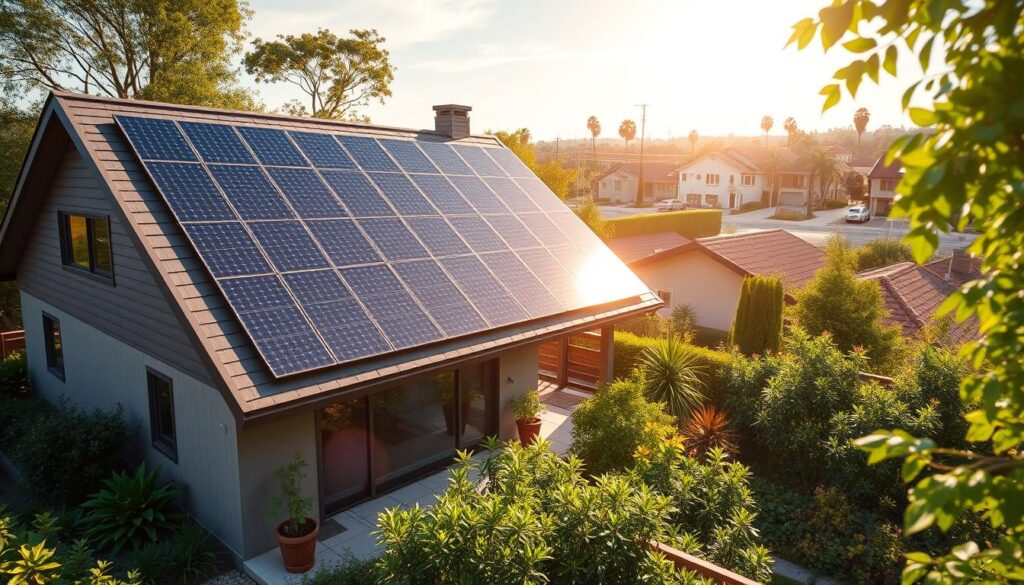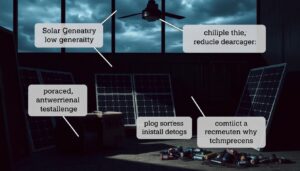Did you know that a single hour of sunlight hitting the Earth’s surface could power the entire world for a year? This staggering statistic highlights the incredible potential of solar energy, a renewable and eco-friendly power source that is rapidly gaining popularity across Australia. As more homeowners and businesses consider transitioning to solar power, it’s crucial to understand the advantages and challenges of this technology to determine if it’s the best choice for your energy needs.
Key Takeaways
- Solar energy is a renewable, clean, and sustainable power source that can reduce your environmental impact and energy costs.
- Installing solar panels can increase the resale value of your home by up to $15,000.
- Solar energy systems have an average lifespan of 25 years, making them a long-term investment.
- While the initial costs of solar installation can be high, you can typically break even within 6-10 years.
- Solar energy is versatile and can be used in a variety of climates, providing reliable power generation year-round.
Understanding Solar Energy
Solar energy is the electrical or thermal energy harvested from the sun’s rays. At the heart of this renewable power source are photovoltaic (PV) cells, which convert sunlight into usable electricity. These cells are made from semiconductor materials, such as silicon, that absorb the sun’s photons and release electrons, generating an electric current.
Solar panels, the building blocks of solar energy systems, are arrays of interconnected PV cells that capture the sun’s energy and channel it into the electrical grid or a home’s power supply. By strategically placing solar panels in areas with abundant sunlight, homeowners and businesses can significantly reduce their reliance on traditional fossil fuel-based electricity, lowering their carbon footprint and energy costs.
| Key Facts about Solar Energy | Value |
|---|---|
| Solar technologies can support the world’s energy consumption for a full year with just an hour and a half of sunlight striking the Earth’s surface. | 1.5 hours |
| Soft costs, such as permitting, financing, and customer acquisition, represent the largest share of total costs for rooftop solar energy systems. | Largest share |
| The Solar Energy Generating System (SEGS) in the Mojave Desert can generate over 650 gigawatt-hours of electricity per year. | 650 GWh/year |
The efficiency and versatility of solar energy make it a promising solution to the world’s growing energy demands. As technology continues to evolve, the future of this renewable power source looks brighter than ever.
“Solar energy systems are being installed across the United States, with utilities building large solar power plants to provide energy.”
Advantages of Solar Energy
As a renewable and clean energy source, solar power offers several advantages that make it an attractive option for homes and businesses alike. Solar energy is not only environmentally friendly but can also help reduce your electricity bills and provide a sense of energy independence.
Renewable and Clean Energy Source
Solar energy is a renewable resource that does not deplete over time. Unlike fossil fuels, solar power generation does not release any greenhouse gases or other harmful emissions, making it a clean and sustainable energy solution. In fact, between 2010 and 2019, solar energy’s share of the global energy mix increased from 0.06% to 1.11%, showcasing its growing prominence as a viable renewable energy source.
Reduced Electricity Bills
One of the primary advantages of installing a solar energy system is the potential to significantly reduce your electricity bills. With the average cost of solar PV modules decreasing by 62% annually for residential systems, the initial investment in solar can be offset within 4 to 7 years through the savings on your power bills. This makes solar energy an increasingly attractive option for homeowners and businesses alike.
Energy Independence
By generating your own electricity on-site, solar power allows you to become less dependent on the traditional power grid. This energy independence can be particularly beneficial in remote or off-grid locations, as well as in areas prone to power outages. With the cost of utility-scale storage systems for solar energy continuously declining, the ability to store excess solar energy for later use further enhances this advantage.
Overall, the renewable and clean nature of solar energy, the potential for reduced electricity bills, and the increased energy independence it provides make it a compelling choice for those looking to harness the power of the sun and reduce their environmental impact.
Is solar energy the best?
As the world increasingly seeks renewable and sustainable energy solutions, the question arises: is solar energy the best option? The answer to this query depends on a variety of factors, including your location, energy needs, budget, and personal preferences. Let’s explore the pros and cons of solar energy to help you determine if it is the optimal choice for your situation.
Pros of Solar Energy
- Renewable and Clean Energy Source: Solar energy is a renewable resource that produces no greenhouse gas emissions, making it an environmentally friendly choice.
- Reduced Electricity Bills: By generating your own electricity through solar panels, you can significantly reduce your reliance on the grid and lower your monthly electricity costs.
- Energy Independence: Solar energy allows you to take control of your energy supply, reducing your dependence on utility companies and providing a measure of energy security.
Cons of Solar Energy
- High Initial Costs: The upfront installation costs for solar panels can be substantial, though the long-term savings often outweigh this investment.
- Sunlight Dependence: Solar energy generation is dependent on the availability of sunlight, which can be a challenge in certain climates or during periods of inclement weather.
Ultimately, whether solar energy is the best choice for you depends on carefully weighing the pros and cons against your specific needs and circumstances. By doing your research and considering all the factors, you can make an informed decision that aligns with your goals and priorities.
| Metric | Value |
|---|---|
| Solar Energy Potential | 173,000 terawatts of energy reach the Earth daily, which is 10,000 times the global daily energy consumption. |
| Largest Solar Energy Plant | The Bhadla Solar Park in Rajasthan, India, covers 10,000 acres and has a capacity of 2,245 megawatts, with an estimated investment of $1.4 billion. |
| Largest Solar Park in the US | The Solar Star park in Rosamond, California, consists of two installations with capacities of 314MW and 265MW respectively. |
As the solar industry continues to evolve and become more cost-competitive compared to fossil fuels, the pros of solar energy may outweigh the cons for an increasing number of homeowners and businesses. By understanding the nuances of this renewable energy source, you can make an informed decision that aligns with your sustainable energy goals.
Increasing Home Value with Solar Panels
Investing in solar panels can be a game-changer for homeowners looking to boost their property’s value. According to a Zillow study, homes with solar panels installed can see an average increase of around 4% in their value. This translates to a significant financial advantage, especially in today’s competitive housing market.
The benefits of solar energy extend beyond just reducing electricity bills. Homes with solar panels tend to sell 20% faster than those without, as potential buyers recognize the long-term savings and eco-friendly advantages. In fact, the National Renewable Energy Laboratory found that each dollar a solar panel saves on your electrical bills increases the value of your home by $20.
The demand for solar-powered homes is particularly high in certain regions, such as California, Colorado, Massachusetts, New Jersey, New Mexico, and Oregon. Major cities like Los Angeles, San Diego, Honolulu, Phoenix, San Jose, San Antonio, and New York also see a significant interest in solar-equipped properties.
| Benefit | Impact |
|---|---|
| Reduced Electricity Bills | $20 increase in home value per $1 saved |
| Faster Home Sales | 20% faster than homes without solar |
| Increased Property Value | Around 4% increase on average |
Solar incentives, tax credits, and rebates can further enhance the financial benefits of installing solar panels, making them more affordable and improving the return on investment. With the potential for long-term savings and a significant boost in home value, it’s no wonder that solar energy is becoming an increasingly attractive feature for homebuyers.

“Between 2022 and 2032, solar panel installations may benefit from a potential solar tax credit of up to 30% off the total cost of the system.”
Whether you’re a homeowner looking to increase the value of your property or a prospective buyer seeking a sustainable and cost-effective home, the benefits of solar panels are clear. By embracing this renewable energy source, you can not only enjoy the environmental and financial advantages but also set your home apart in the competitive housing market.
Low Maintenance Costs
One of the key advantages of solar energy is the relatively low maintenance costs associated with solar panel systems. Unlike traditional electricity sources, solar panels have no moving parts that wear out over time, making them a remarkably low-maintenance investment.
Regular cleaning and inspections are typically the primary maintenance requirements for solar panels. Professional cleaning and inspection services usually cost around $150 per year, ensuring your solar system continues to function at optimal efficiency.
Moreover, most reputable solar panel manufacturers offer extensive warranties, often ranging from 20 to 25 years. These warranties provide long-term assurance, covering performance guarantees and any potential issues that may arise. With an average lifespan of 25-30 years, solar systems can deliver substantial long-term value and cost savings with minimal ongoing maintenance.
Advancements in solar technology have also contributed to the reduced maintenance requirements. Solar panels now have fewer components, and the inverters, a crucial part of the system, may only need replacing every 5-10 years due to continuous use.
The lack of moving parts in solar energy systems further reduces the need for maintenance and servicing, as there is less wear and tear over time. This translates to substantial savings for homeowners and businesses, making solar energy an increasingly attractive and cost-effective choice for power generation.
Versatility of Solar Energy
Solar energy is an incredibly versatile renewable resource that can be harnessed to power a wide range of applications, from homes and businesses to remote off-grid locations and even satellites. One of the key advantages of solar energy is its ability to function efficiently in a variety of climates, making it a suitable option for homes and businesses across Australia.
Diverse Applications
Solar panels can be used to generate electricity, power water distillation systems, and even fuel satellites in space. The versatility of solar energy allows it to meet the energy needs of both small-scale and large-scale operations, making it a valuable asset in diverse settings.
Suitable for Various Climates
Solar panels continue to operate efficiently even in cold temperatures, and the snow can actually help by reflecting more sunlight onto the panels as it melts. While cloudy days may temporarily reduce electricity production, the panels can still function and generate power, ensuring a reliable energy source in a range of climatic conditions.
“One hour of sunlight on Earth theoretically can meet global energy needs for an entire year.”
The versatility of solar energy, coupled with its ability to adapt to various climates, makes it a truly remarkable renewable resource that can be harnessed to meet the energy demands of homes, businesses, and even remote off-grid locations across Australia.
Challenges of Solar Energy
As promising as solar energy is, it faces several challenges that must be addressed for its widespread adoption. One of the primary hurdles is the high initial cost of installing a solar energy system. Despite the declining prices of solar panels over the past decade, the upfront investment required can still be significant, often averaging around $18,000 before incentives and tax credits. This substantial financial barrier can deter some homeowners and businesses from transitioning to solar power.
Another challenge of solar energy is its dependence on sunlight. Solar panels rely on the sun’s rays to generate electricity, which means that energy production can fluctuate based on weather conditions. Cloudy days or nighttime hours can reduce solar energy generation, making energy storage solutions like batteries an important consideration to ensure a consistent power supply.
| Challenge | Description |
|---|---|
| High Initial Costs | The upfront investment required for a complete solar energy system can still be substantial, with the average cost around $18,000 before incentives and tax credits. |
| Sunlight Dependence | Solar energy generation is dependent on the availability of sunlight, which can fluctuate due to weather conditions, leading to potential inconsistencies in power supply. |
Despite these challenges, the solar energy industry in Australia continues to evolve, with advancements in technology and the implementation of supportive policies and incentives. As the cost of solar panels decreases and energy storage solutions become more efficient, the adoption of solar power is expected to continue growing, providing a clean and renewable energy source for homes and businesses across the country.
Solar Energy Storage Solutions
As the adoption of solar energy continues to grow, the need for effective storage solutions has become increasingly crucial. One of the primary challenges of solar power is its dependence on sunlight, which can be intermittent and unreliable. To mitigate this, advancements in battery technologies have provided a promising way to store excess solar energy generated during the day for use during periods of low sunlight or nighttime.
Battery Technologies
Among the leading battery technologies used for solar energy storage, lithium-ion batteries have emerged as a popular choice. These batteries, which are commonly used in consumer electronics and electric vehicles, offer high energy density, long lifespan, and relatively low maintenance requirements. Other battery chemistries, such as nickel-based and flow batteries, are also being explored for energy storage for solar applications.
The capabilities of these battery systems have steadily improved, allowing them to store more power and provide longer durations of energy supply. This helps address the solar energy storage challenge, ensuring that solar power can be reliably used even during periods of low sunlight or at night.
As the cost of battery technologies continues to decline, solar-plus-storage systems are becoming increasingly accessible to residential, commercial, and utility-scale solar operators. In Australia, for example, over 250,000 home storage batteries were installed by 2024, taking advantage of government rebate schemes and the growing affordability of these solutions.
While the initial investment in a home solar battery system may be higher, the long-term benefits, including reduced reliance on fossil fuel-based electricity and potential for faster return on investment, make these technologies an increasingly attractive option for homeowners and businesses alike.

“Solar energy storage is the key to unlocking the full potential of renewable power, ensuring a reliable and consistent energy supply for our homes and communities.”
Environmental Impact of Solar Energy
The environmental impact of solar energy is a complex topic that requires a balanced consideration. While solar energy is widely recognized as a clean and renewable source of electricity, the manufacturing process for solar panels does have some environmental implications that cannot be overlooked.
The mining of raw materials and the production of solar panels generate greenhouse gas emissions, which contribute to climate change. However, studies have shown that solar panels typically pay back their environmental cost within one to four years of use, making them a much more sustainable option compared to fossil fuels in the long run.
- A recent study by the Department of Energy’s Solar Futures Study estimates that solar energy development could require as much as 5.7 million acres of land, about 0.3% of the contiguous U.S., by 2035.
- Solar developers evaluate multiple sites, site designs, and operation strategies during the siting and permitting of solar projects to minimize environmental impact.
- SETO-funded research focuses on areas such as wildlife-solar interactions, stormwater runoff, water quality, and soil health to address the environmental concerns associated with solar energy.
As the solar industry continues to grow and improve its manufacturing processes, the environmental footprint of solar energy is expected to become even more favorable. Initiatives like the Avian-Solar Multi-Agency Collaborative Working Group and the Avian Solar Working Group are working to better understand the impact of solar facilities on wildlife and the environment.
While the environmental impact of solar energy cannot be completely eliminated, the industry’s commitment to sustainable practices and ongoing research is making significant strides in minimizing the environmental impact of solar energy, solar energy sustainability, and solar panel manufacturing emissions.
“Solar energy systems have seen a significant rise in importance in recent years due to their ability to generate clean, non-polluting electricity with no global warming emissions.”
Conclusion
In conclusion, solar energy offers a range of benefits that make it a compelling renewable option for homes and businesses in Australia. From its renewable and clean energy source to the potential for reduced electricity bills and increased home values, solar power has significant advantages. However, it also faces some challenges, such as high upfront costs and dependence on sunlight. By carefully weighing the pros and cons, and exploring the latest advancements in solar technology and storage solutions, you can determine if solar energy is the best choice for your energy needs and sustainability goals.
The sun is a reliable and abundant energy source, and solar power harnesses this natural resource to generate clean, renewable electricity. Solar panels, with their semiconducting silicon cells, are increasingly accessible and easy to install, making solar energy a viable option for both personal and industrial use. Moreover, solar systems are designed to be durable and require minimal maintenance, lasting up to 20-25 years with a manufacturing warranty of 15-20 years.
The Australian government’s solar rebates and incentives further encourage the adoption of solar power, with many homeowners and businesses finding that their solar systems pay for themselves within 4 to 5 years. Grid-connected solar systems offer additional financial benefits, such as selling excess power back to utility companies and reducing utility bills through net metering. Additionally, solar batteries provide energy independence by storing excess energy for use during non-sunny periods, enhancing the overall reliability and stability of solar power.



